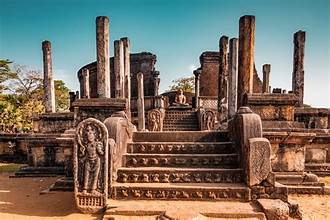…Polonnaruwa…
Polonnaruwa: A Glimpse into Sri Lanka’s Glorious Past
Polonnaruwa, an ancient city in Sri Lanka’s North Central Province, is one of the country’s most historically significant sites. Declared a UNESCO World Heritage Site in 1982, it served as the capital of Sri Lanka during the 11th to 13th centuries and stands today as a testament to the island’s rich medieval history. Known for its impressive ruins of palaces, temples, and monumental sculptures, Polonnaruwa is a treasure trove of archaeological marvels that attract visitors from around the world.
A Brief History
Polonnaruwa became the capital of Sri Lanka after the fall of Anuradhapura, the island’s first capital, in 993 CE due to invasions from South India. The city rose to prominence under King Vijayabahu I, who unified Sri Lanka after defeating the Chola invaders in the late 11th century. His victory marked the beginning of Polonnaruwa’s golden age, which reached its peak under his successor, King Parakramabahu I (1153–1186).
King Parakramabahu is celebrated as one of the greatest monarchs in Sri Lankan history. His reign was characterized by extensive construction projects and the development of advanced irrigation systems, many of which still function today. Under his rule, Polonnaruwa became a thriving center of commerce, culture, and religion.
The city’s decline began after the 13th century due to internal conflicts and invasions from the South Indian kingdom of Pandya, ultimately leading to its abandonment in favor of other capitals. However, the remnants of its architectural and cultural grandeur endure, offering a fascinating window into Sri Lanka’s past.
Key Highlights of Polonnaruwa
- Royal Palace Complex
- The Royal Palace, built by King Parakramabahu I, is one of the most significant structures in Polonnaruwa. Although only parts of the palace survive today, it is believed to have originally been a seven-story building with over a thousand rooms. The remaining walls still showcase the grandeur of this ancient royal residence.
- Polonnaruwa Vatadage
- The Vatadage is one of the most iconic structures in Polonnaruwa. This circular relic house, built to protect a sacred stupa, exemplifies the architectural skill of ancient Sri Lanka. Adorned with intricate stone carvings, including a beautifully carved moonstone at its entrance, it remains one of the best-preserved monuments of the era.
- Gal Vihara
- Perhaps the most famous site in Polonnaruwa is Gal Vihara, a rock temple featuring four massive statues of the Buddha carved into a single granite rock face. These statues, representing different postures of the Buddha (seated, standing, and reclining), are considered masterpieces of ancient Sinhalese stone carving. The serene expressions and fine details make Gal Vihara a spiritual and artistic highlight.
- Parakrama Samudra (Sea of Parakrama)
- A testament to the advanced engineering of the time, the Parakrama Samudra is a massive artificial lake covering over 2,500 hectares. Built by King Parakramabahu, it served as an essential irrigation reservoir, supporting agriculture and providing water to the capital. The king’s famous words, “Let not even a drop of rainwater flow into the sea without being used,” reflect his dedication to optimizing water resources.
- Rankoth Vehera
- Rankoth Vehera is the largest stupa in Polonnaruwa, standing at 55 meters tall. Built by King Nissanka Malla in the 12th century, it resembles the stupas of Anuradhapura and signifies the continuity of Buddhist architecture during Polonnaruwa’s era. Surrounding the stupa are smaller stupas and shrines, creating a sacred area for worship.
- Lankathilaka Image House
- Lankathilaka is a grand image house that once housed a massive statue of the Buddha, now partially ruined but still impressive. The structure is 55 feet high and showcases the grandeur of Buddhist architecture in Polonnaruwa. Its towering walls and the remaining fragments of the Buddha statue offer a sense of the scale and craftsmanship involved in its construction.
- Kiri Vehera
- Kiri Vehera, a white-domed stupa, is another important religious structure in Polonnaruwa. It is relatively well-preserved and is thought to have been built by King Parakramabahu’s queen. The stupa is named “Kiri,” meaning “milk,” due to its original gleaming white plaster, which resembled milk in color.
- The Sacred Quadrangle
- The Sacred Quadrangle, or Dalada Maluwa, is a compact group of ruins at the heart of Polonnaruwa, featuring some of the city’s most revered religious monuments. This area includes the Vatadage, the Hatadage (a relic chamber), and the Thuparama, an image house. The concentration of monuments here suggests it was a central point for religious activity in ancient Polonnaruwa.
Cultural and Religious Significance
Polonnaruwa is not just a symbol of political power but also of Sri Lanka’s religious and cultural heritage. The city was a major center of Theravada Buddhism, and many of its monuments reflect the strong Buddhist identity of the island. During its height, Polonnaruwa attracted scholars, monks, and artisans, contributing to a flourishing of religious and artistic expression. The detailed sculptures, intricate carvings, and monumental statues are all a reflection of this cultural richness.
Preservation and Modern-Day Importance
Today, Polonnaruwa is a popular tourist destination, attracting history enthusiasts, pilgrims, and photographers. The Sri Lankan government and international organizations, such as UNESCO, have worked to preserve and protect the ruins. The site’s significance lies not only in its historical and architectural importance but also in its connection to Sri Lanka’s identity.
Visitors to Polonnaruwa can explore the well-preserved ruins, walk through ancient palace complexes, and meditate by the serene Buddha statues at Gal Vihara. The experience offers a deep connection to the past, providing a glimpse into a once-thriving civilization that left an indelible mark on Sri Lanka’s landscape and cultural heritage.
Conclusion
Polonnaruwa stands as a monumental tribute to Sri Lanka’s medieval glory, reflecting the island’s resilience, creativity, and devotion. Its ruins, though weathered by time, continue to inspire awe and respect. For anyone interested in history, culture, and religion, a visit to Polonnaruwa is a journey through the heart of Sri Lanka’s illustrious past, a reminder of the nation’s rich heritage and the brilliance of its ancient civilizations.

